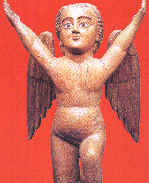|
|
"Mother of Balboa Park", horticulturalist Kate Sessions leased 30 acres of barren hills for nursery. In exchange, she promised to plant 100 trees each year, plus donate 300 ornamental trees to the city. By 1914, she moved her nursery to Pacific Beach. Brothers John and Adolf Spreckels donated the outdoor organ, which was built and dedicated in 1914 and is the largest in the world.
Site of the 1915-16 and 1935 World Exposition, St. Francis Chapel and the lily pond still remain in tact. During World War One, the lily pond was used as swimming pool and boat survival training area.
The city's only embarrassment, in 1935, was nudist colony called Zoro Gardens, which sprouted up around the many park activities. During World War Two, Balboa Park changed radically, as it became the nation's foremost corpsman training center and was nicknamed "Camp Kid". The round building, now called "Centro Cultural de la Raza", was originally hospital auxiliary water tank.
Today, the 1400-acre park is the vibrant cultural heart of San Diego. Galleries and Museums are toured by visitors throughout the world. In fact, Balboa Park is like no other place, cultural complex second only to Smithsonian in size.
62 feet tall Moreton Bay Fig tree behind the History Museum was planted in 1915 and has canopy of over 100 feet in diameter. Trees, which line Hwy. 163 around the Park are Sycamores. The fountain in the Plaza was built in 1972, holds 28,000 gallons of water and spouts over 60 feet in the air, making it the tallest in San Diego.
"Prado" is named after a famous promenade in Madrid and 11th century Spanish hero "El Cid Campeador" is statue in Plaza de Panama, built in 1930. Five famous 17th-century artists grace in the entryway to Museum of Art. They are Murillo, Velasquez, Zurbaran, Ribera and El Greco.

|
|

